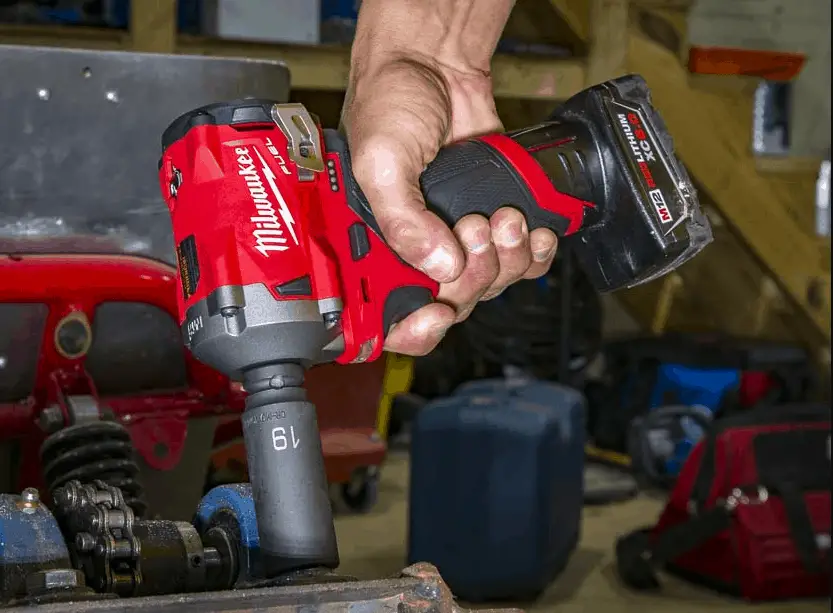The size of an air compressor does not signify its power, given that the largest part of an air compressor is its tank. The size of the tank indicates how long the compressor can supply the tool you are using before it needs to refill with more compressed air.
If you are working with tools requiring a continuous flow of air such as spray painting and sanders, then it’s best to go with one that has a larger tank. When looking at air compressors for impact wrenches, it helps to first know the mechanics of how one functions.
An impact wrench is used for attaching and removing fasteners, nuts, and bolts powered by an electric or air motor and can be found in most mechanics tool boxes. This tool stores its power in a spinning mass and can deliver a powerful force of energy when released with minimal exertion on the user’s behalf.
Because this tool does not require continuous airflow, choosing a 60-gallon air compressor over a 120-gallon would be more than sufficient. There are a few factors to consider before deciding which unit would be best to work with your tools.
Job Application
Your job requirements will affect the proper air compressor needed. If you need a unit to power tools needing an exorbitant amount of torque, then you will want one which can produce a higher CFM and perhaps a larger tank if multiple users will use it.
If you are using impact wrenches at home for personal use, then a smaller air compressor would be suitable.
Size of the Impact Wrench
Because of the variation in size, the airflow (CFM) needed for each impact wrench will vary. The larger sizes will require more airflow and pressure (PSI).
The greater these two qualities are, the more power the tool will exert. In theory, if you connect a 1-inch impact wrench to your air compressor with a CFM of 3, there will not be a sufficient amount of airflow to power the tool and provide the proper torque needed.
For this particular size, you would need an air compressor with a CFM of anywhere between 9-10. This size of impact wrench is not very common and is usually found in industrial applications.
Location
The size of the air compressor you choose will depend on your workspace. If you travel to multiple sites, then you will want to look for one with the proper CFM and tank size, with the option of being portable, keeping in mind tank size is not dependent on a continuous flow of air with these tools, so a smaller tank will be suitable.
If your job doesn’t require portability, then a larger stationary air compressor would be ideal.
Tank Size
As mentioned earlier, impact wrenches do not require a continuous amount of airflow. However, for peace of mind, if you want to find the minimum size needed on a compressor then you would multiply the CFM of the wrench by 6.
For example, if the CFM of a wrench is 4, then you would multiply that by 6 giving you a recommendation for a tank size of 24 liters. Converted to gallons, this would roughly be a little over 5 gallons.
CFM required of the tool
The CFM is the amount of airflow generated by the compressor and is the most important feature when looking at how it affects the use of impact tools.
The higher the CFM, the greater the torque of the tool used. The manual and the manufacturer’s website will provide information regarding the proper CFM guidelines.
A general rule is to locate the tools CFM requirements and multiply by 1.5. This will give you the proper CFM needed in an air compressor to power the tool.
Horsepower
Depending on the use of the impact wrench is a great way in determining the horsepower needed, as they vary in power usually from 1 to 15 HP.
The greater the HP, the larger the amount of airflow generated. A 2 HP will generate between 4-8 CFM at a force of 90 to 100 PSI, which will provide the required CFM needed for impact wrenches sized from ¼ inch to ⅜ inch.
Using An Impact Wrench With An Air Compressor
- Plugin the air compressor and turn it on
- Attach the impact wrench to the end of the air compressor hose and put on your safety googles
- Set the PSI and CFM accordingly
Benefits of Using Impact Wrenches With Air Compressors
- Air-powered provides a longer lifespan of the tool
- Ability to control torque
- Rate control
- They generate less heat
There are so many benefits of using an air compressor with any tool, and impact wrenches are no different.
Impact wrenches that are powered by electricity may not work as efficiently as ones that are powered by air, as they don’t always provide the same amount of torque. The less force that a user has to exert, the better.
Suggestions Of Impact Wrench and Air Compressor
Professional Air Tool Kit
- 500 foot-lbs of torque
- Crafted with steel
- Forward/reverse settings
- Includes air impact wrench and ratchet
Ingersoll Rand Air Impact Wrench
- 1300 foot-lbs of torque
- Four-position power regulator
- Lightweight at 4.6 lbs
- Steel wear plate
California Air Compressor
- 6.40 CFM at 40 PSI & 5.30 CFM at 90 PSI
- 2 HP
- Quiet
- 10-gallon tank
- Portable
- 3000-hour lifespan before service
Final Thoughts
We should not base a recommendation solely on one type of tool when choosing an air compressor. A suggestion would be to purchase an air compressor that can function with whatever task we choose to perform with it.





